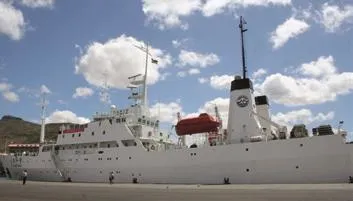Deep Sea Discoveries
2010-09-12ByTANGYUANKAI
By TANG YUANKAI
Deep Sea Discoveries
By TANG YUANKAI
China’s second global maritime expedition yields impressive results on ocean dwelling sea life and hydrothermal vent activities

After 315 days, 53,300 nautical miles of voyage and a number of scientific observations, Dayang Yihao (Ocean 1), an oceanic research ship of China, docked at Qingdao port, Shandong Province, on May 28, 2010. The research ship completed a transoceanic expedition across the Pacific, Atlantic and Indian oceans, the second such global maritime mission for a Chinese vessel. The vessel set sail on July 18, 2009.
Overall, the 5,600-ton Ocean 1 has completed 21 scientifc expeditions.
The biggest breakthrough in the vessel’s mission was the discovery of new hot liquid sulfde areas in the Atlantic Ocean, said Tao Chunhui, chief scientist for the maritime exploration, who has taken part in numerous scientifc research voyages since 1994.
“So far, only three hot liquid sulfide areas have been discovered in the south Atlantic. We discovered two in seven days,”Tao said.
Chinese scientists discovered a total of five hot liquid sulfide areas during this expedition—two in the Atlantic Ocean, two in the Pacific and one in the Indian Ocean, said Tao.
In 2007, Tao and other members discovered the first active new hot liquid sulfide area in the southwest Indian Ocean and in an ultra-slow expanding mid-ocean ridge. Now, one tenth of all the hot liquid sulfide areas discovered worldwide were found by Chinese scientists.
Hot liquid sulfde areas are usually very narrow, spanning hundreds of meters and are found along mid-ocean rides and back-arc basins at depths of thousands of meters, said Tao. Thus, fnding them is like searching for a needle in the ocean.
Hot liquid sulfde areas are characterized by thick black, white or yellow hot liquids spewing forth like smoke from cracks in the ocean floor, Tao said. These liquids then crystallize and collect on the ocean floor. Sulfdes of non-ferrous metals and precious metals, such as copper, zinc, iron, gold and silver, gush out of the Earth’s crusts incessantly at some of these locations.
Research on hot liquid sulfide areas may help explain the origin of life or process of evolution. An incredible number of living organisms such as shrimps, clams, fish and algae flourish in the depth of the ocean where the temperature near the hydrothermal vents of a hot liquid sulfde area approximates 400 degrees centigrade and the barometric pressure is a few hundred atmospheres.
These hydrothermal vent organisms depend on chemosynthetic bacteria for food. These bacteria produce organic material through chemosynthesis, the conversion of carbon molecules and nutrients into organic matters. This ecosystem differs from that on the Earth’s surface, which is based on solar energy. These deep sea organisms could represent the Earth’s early life forms and carry valuable genes.
The hydrothermal vents in the hot liquid sulfide areas are often called “black smokers,” which are tall structures along the seabed that belch dark smoke and can reach 26 meters in height and have a diameter of 4.5 meters. Finding “black smokers” and analyzing the sulfides erupted from them were another mission of Ocean 1’s exploration this time.
Scientists further studied a “black smoker” they discovered at a depth of 3,000 meters during a previous expedition in the Indian Ocean and collected samples of the unique creatures living in the dark ocean near high-temperature centers under high barometric pressure.
“We made the most achievements in the southwest Indian Ocean. The large scale seismologic array detection carried out at the mid-ocean ridge of the ocean was the first of its kind conducted by a Chinese research team,” said Tao.
His team placed ocean-bottom seismometers, such as a network of seismic wave receptors, to collect submarine seismological data and learn about the deep-sea geological conditions. They also employed 3D seismic imaging technology to study the hydrothermal activities at the mid-ocean ridge in the Indian Ocean.
During the expedition of the Ocean 1 this time, scientists used a new remotely operated vehicle (ROV) for underwater exploration to collect samples from the hot liquid sulfide areas. The ROV, about 3.8 meters tall, can pick up goods as heavy as 250 kg. It is China’s only hi-tech vehicle that can operate in treacherous oceanographic conditions about 3,500 meters deep underwater. The successful operations of the ROV made China one of the few countries to use a deep-sea robot to conduct studies on hot liquids being emitted from mid-ocean ridges.
Other advanced research devices, including a deep-sea tugboat with acoustic tracking system, a fber optic cable deep-sea rock core drilling machine and a deep-sea biological sampler, also made their successful debuts during the mission.
The deep-sea tugboat looks like a gigantic steel cage equipped with precise instruments such as a deep-sea camera that can withstand very high temperatures and barometric pressure. The camera can transmit underwater images to computer monitors in a laboratory on the Ocean 1.
